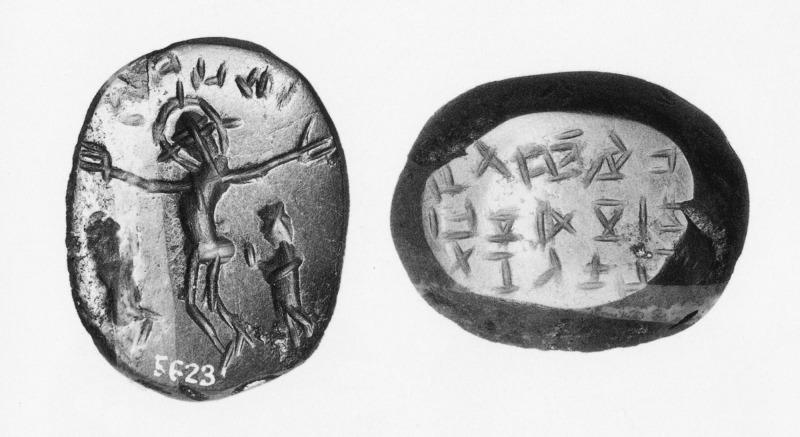Bonner, SMA, 226.
A small mottled stone, reddish and dark green, probably heliotrope, is an unusually interesting monument of the cult of saints (56269). A man with nimbus round his head holds over his head with his left hand a fish (the Christian emblem), while the right is raised as prayer or blessing. The figure stands on a crocodile, a mark of Egyptian origin.
The most interesting of the group (56469) is a roughly executed brown stone; I was not sure of the material. At the foot of a tree a woman is shown in the act of giving birth to a child while she holds an ankh, or crux ansata, the symbol of life, in her hand. A man and an uncertain animal stand near by. On the reverse are a large ankh and the inscription εἷς θεός ἐν οὐρανῷ.
The last of the four (56231) is an extremely crude representation of the crucifixion, done on a red jasper with a vertical band of yellow. The central figure stands with arms extended, but no part of the cross is actually visible. On each side, at a lower level, is a mourner. Unknown characters are cut in the upper field, and the whole reverse side and the edge are inscribed with similar signs. This stone and the preceding one are illustrated in Budge, The Mummy, Pl. 24.
Only two objects that seem to be Jewish need be considered here. The first, a small lead phylactery in the form of a horizontal oblong with two suspension loops, has been previously published and needs only a brief comment.66 The piece came from Syria. One side is inscribed Ρεφαηλ, the other Σαβαω. Mouterde, who first published it, rightly remarked that on this object Sabaoth is conceived to be an angel no less than Raphael. The inscriptions on both sides run from right to left, and since it does not seem likely that a thin lead plate would be used as a seal, one wonders whether the Jewish custom of writing from right to left suggested to the maker a similar practice with Greek letters.
Much more interesting is a limonite pendant in the Newell collection (D. 343), which represents the sacrifice of Isaac. At the extreme right, on a higher level than the human figures, stands an altar with three horns. Approaching it is the child Isaac, behind whom Abraham walks, grasping a sword, point upward, in his right hand, which is held across his body. He has turned his head to look behind him at a ram standing under a small tree, which bends over sharply, and at a hand which points downward at the ram from a line representing the vault of heaven. At the upper right is a star. The reverse has four lines of a Hebrew or a Samaritan script, of which the first line is almost entirely obliterated and the second considerably damaged by abrasion.
Among the scenes that artists took from the Old Testament Abraham's sacrifice of Isaac is one of the most popular. It was painted on the wall of the synagogue at Dura,67 and rendered in mosaic in that at Beth Alpha;68 and, doubtless because it came to be regarded as a type of the Passion of Christ, it
67 Excavations at Dura-Europos, Sixth Season, p. 343, Pl. 48.
68 E. L. Sukenik, The Synagogue of Beth Alpha, pp. 40–42, Pl. 19.
Last modified: 2012-11-02 12:58:35
Link: cbd.mfab.hu/pandecta/1671




